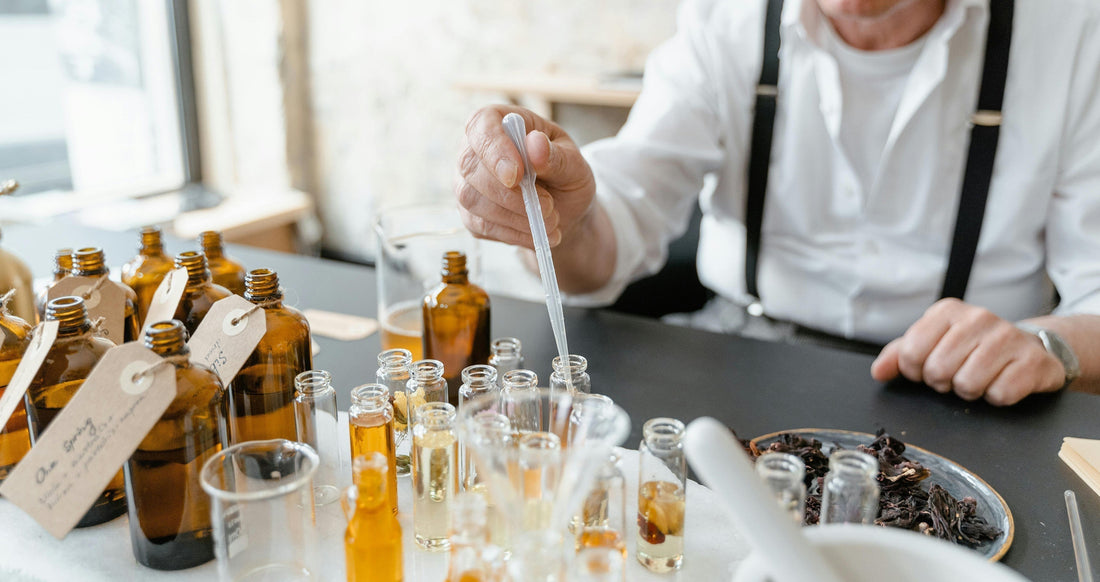
Essential Oil Blending for Beginners: Safe, Simple Recipes & Pro Tips
Share
Introduction: Why Blend Essential Oils?
Blending essential oils is one of the most rewarding ways to personalize your aromatherapy experience. Whether you want to craft a signature scent for your home, create a calming bedtime blend, or simply experiment with different fragrances, blending allows you to customize your oils to suit your exact mood and needs.
Beyond the beautiful aromas, blending is about synergy—combining oils in a way that brings out the best in each one. For example, mixing lavender with frankincense may create a more well-rounded and soothing effect than using either oil alone.
If you're new to the world of essential oils, don’t worry. This beginner-friendly guide will walk you through the basics of blending: understanding fragrance notes, tips for safe use, and even a few simple recipes to get started.
Ready to explore? Discover the full range of possibilities with our Essential Oils Collection and start your blending journey today.
Understanding Fragrance Notes: The Basics of Blending
To create a balanced and long-lasting essential oil blend, it’s important to understand the concept of fragrance notes. Just like in perfumery, essential oils are grouped into top, middle, and base notes based on how quickly they evaporate and how they contribute to the overall aroma.
-
Top Notes
These are the first scents you notice in a blend. They’re light, fresh, and uplifting, but they tend to fade quickly. Think of them as the introduction to your blend’s story. Popular top notes include citrus oils like Lemon Essential Oil and bergamot. -
Middle Notes
Often called the “heart” of the blend, middle notes emerge once the top notes evaporate. They provide balance and depth, tying all the components together. Oils like Lavender Essential Oil and rosemary are classic middle notes. -
Base Notes
These are the foundation of your blend, offering richness and longevity. They evaporate slowly, helping the scent last much longer. Deep, grounding oils such as Frankincense Essential Oil and patchouli are popular choices.
A well-crafted blend typically includes all three notes, allowing the scent to unfold in layers—from the initial fresh burst to the lingering, soothing base.
How to Build a Balanced Blend (Easy Formula)
Now that you understand fragrance notes, it’s time to build your own blend. A good rule of thumb for beginners is the 30-50-20 formula:
-
30% Top Notes
-
50% Middle Notes
-
20% Base Notes
This ratio helps ensure your blend is well-rounded, with a pleasant opening, a rich body, and a long-lasting finish.
Tools You Need to Start Blending
Getting started with blending doesn’t require a huge investment, but having the right tools will make the process easier, safer, and more enjoyable. Here’s what we recommend for beginners:
-
Dark Glass Bottles
Perfect for storing your blends and protecting them from light damage. Aim for small sizes (10ml–30ml) when experimenting. -
Pipettes & Droppers
These allow you to measure your oils drop by drop for precise blending. -
Glass Mixing Bowl or Beaker
A small glass bowl or beaker is ideal for combining your oils before transferring them to storage bottles. -
Labels & Notebook
Keep track of your recipes by labelling each bottle clearly and noting down what you’ve blended. Trust us—you’ll want to recreate your favourites! -
Starter Oil Sets
If you’re looking to jump right in, curated sets like the Designer Set For Her Fragrance Oil Set or the Designer Set For Him Fragrance Oil Collection offer a fantastic way to explore a variety of complementary scents.
Equipped with these essentials, you'll be ready to create safe, balanced, and beautifully scented blends in no time.
🛠️ Step-by-Step Blending Guide:
-
Choose Your Oils
Select one oil from each note group—top, middle, and base. For example:-
Top: Lemon
-
Middle: Lavender
-
Base: Frankincense
-
-
Start with the Base Note
Add a few drops of your chosen base oil first. This anchors the blend and gives you a foundation to build on. -
Add the Middle Note
Introduce your heart oil next, making up around half of your blend. This is where the main character of your scent comes to life. -
Finish with the Top Note
Lastly, add your top note oils. They bring a bright, fresh burst to your blend. -
Test & Adjust
Mix your oils and let them sit for a few minutes. Smell and adjust if needed—sometimes adding just one more drop can balance everything perfectly. -
Dilute for Safe Use
Once your blend is ready, dilute it with a carrier oil before applying to the skin. If you’re unsure where to start, check out our Carrier Oils Guide for helpful tips.
Blending is part art, part science—so don’t be afraid to experiment and tweak as you go!
Beginner-Friendly Blend Recipes to Try
To get you started on your blending journey, here are a few simple and effective recipes. Each is designed to be beginner-friendly, using well-loved oils that work beautifully together.
✨ Relax & Unwind Blend
A calming blend perfect for evening relaxation.
-
3 drops Lavender Essential Oil (Middle)
-
2 drops Bergamot (Top)
-
1 drop Frankincense Essential Oil (Base)
🌿 Fresh & Energising Blend
Uplift your senses with this revitalising combination.
-
3 drops Lemon (Top)
-
3 drops Eucalyptus Essential Oil (Middle)
-
1 drop Rosemary (Base)
🌸 Grounding & Comforting Blend
For those moments when you need to feel centred and calm.
-
2 drops Vetiver Essential Oil (Base)
-
3 drops Geranium (Middle)
-
2 drops Orange Essential Oil (Top)
🔮 Pro Tip:
Once blended, be sure to dilute your recipe in a carrier oil for safe topical use, or add it directly to your diffuser for aromatic enjoyment.
Experiment, tweak, and make these recipes your own—it’s all part of the fun of blending!
Bonus: Can I Blend Fragrance Oils Too?
Absolutely! While essential oils are the go-to for natural aromatherapy, fragrance oils are a fantastic option for those who want to experiment with unique, designer-inspired scents. Fragrance oils are typically used for home fragrance, candles, and personal products rather than therapeutic purposes.
Blending fragrance oils works much like essential oils—you can mix complementary scents to create something truly your own. Here are a couple of fun ideas to try:
🌟 Sweet & Exotic Blend
This pairing combines the playful sweetness of Snow Fairy with the rich, woody depth of Oud for a luxurious home scent.
🔥 Bold & Musky Blend
Perfect for a confident, powerful scent with layers of spice and musk.
🛑 Quick Reminders:
-
Fragrance oils are different from essential oils—they’re designed for scent, not therapeutic use.
-
Always follow safe usage guidelines, especially when making products like candles, wax melts, or room sprays.
-
For more inspiration and tips, visit our Fragrance Oils Collection.
FAQs: Your Top Questions Answered
Q: Can I use essential oils undiluted on my skin?
A: No, we strongly advise against using essential oils undiluted. They are highly concentrated and can cause irritation or allergic reactions. Always dilute them with a carrier oil—aim for no more than 1% essential oil to 99% carrier oil for safe use.
Q: How long do essential oil blends last?
A: When stored in dark glass bottles and kept away from heat and light, essential oil blends typically last between 6–12 months. Keep in mind that citrus oils (like lemon and orange) oxidise faster and may need to be used within 6 months for best results.
Q: What’s the difference between essential oils and fragrance oils?
A: Essential oils are natural plant extracts, while fragrance oils are either synthetic or a blend of natural and synthetic ingredients. Essential oils are popular for their aromatherapy benefits, while fragrance oils are primarily used for scent in products like candles and perfumes. You can explore more in our detailed guide: Fragrance Oils Explained.
Q: Can I blend oils for hair or skin use?
A: Yes, but be extra cautious. Only use oils that are known to be skin-safe, and always dilute well. Some oils—like lavender and tea tree—are commonly used in hair care, but others may be too strong or sensitising. Not sure where to start? Our Carrier Oils Guide is a great resource.
Q: Is blending only for diffusers?
A: Not at all. Blending can be used in diffusers, room sprays, bath oils, massage blends, wax melts, and more. Always ensure you’re using the appropriate oils and safe dilution ratios for each type of product.
Q: How many oils can I blend at once?
A: While you can technically blend as many as you like, we recommend keeping it simple—especially if you're new to blending. Starting with 3 to 5 oils (a top, middle, and base note) usually yields the best and most balanced results.
Q: Do I need to let my blend "mature"?
A: It’s a good idea! After blending, allow your mixture to rest for at least 24 hours to let the scents meld together. For more complex blends, letting them sit for a week can enhance the harmony of the final scent.
Q: Can I blend essential oils and fragrance oils together?
A: We generally recommend keeping them separate because they behave differently. Essential oils are more delicate and can react differently to heat or other ingredients compared to fragrance oils. For best results, blend essential oils with essential oils, and fragrance oils with other fragrance oils.
Q: What’s the best way to test a new blend?
A: Before making a large batch, test your blend in a small amount—just a few drops total. Add it to your diffuser or mix with a carrier oil and apply to a cotton pad to smell how it evolves over time.
Q: Are there oils I should avoid blending?
A: Some oils, like cinnamon or clove, are very potent and can overpower a blend or cause irritation if used too generously. Always research each oil’s properties and recommended uses before blending, and keep your blends balanced for the best results.
🔗 You Might Also Like to Read:
-
Using Essential & Fragrance Oils on Skin Safely and Effectively: Tips and Best Practices
-
Fragrance Oils Explained: Uses, Safety, Differences, and How to Get the Best Results
-
Your Guide to Carrier Oils: Benefits, Uses, and How to Choose the Best One
Wrap-Up: Start Your Blending Journey Today
Blending essential oils is a wonderful way to personalise your aromatherapy experience—whether you're creating a calming bedtime mix, a fresh energising diffuser blend, or experimenting with fragrance oils for home scenting. With just a few simple tools and the right oils, you can craft unique blends that suit your mood, your space, and your wellbeing goals.
Remember to keep it safe: always dilute properly, patch test new blends, and store your creations carefully. Whether you're using essential oils or designer-inspired fragrance oils, the key is to enjoy the process and find combinations that work best for you.
Ready to start blending? Browse our full Essential Oils Collection or explore the creative possibilities in our Fragrance Oils Collection to spark your inspiration.
Happy blending!



